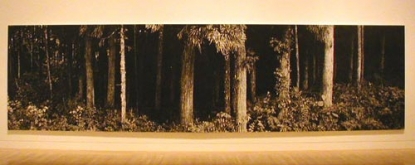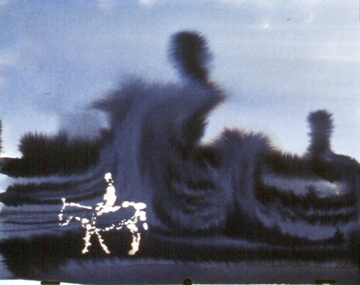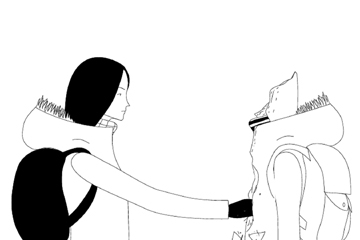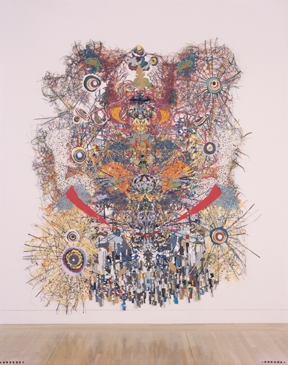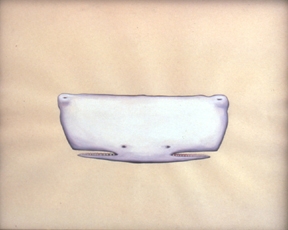Feature: Reviews
International Paper: Drawings by Emerging Artists
- UCLA Hammer Museum
- 10899 Wilshire Blvd., Los Angeles, CA
- January 26 - April 27, 2003
The title for the Hammer Museum’s recent survey of drawings by emerging artists - “International Paper” - was something of a misnomer. More than one third of the work in the exhibition was made in L.A, and several works had only a tangential relationship to paper. For once, it was a joy to be misled. The lack of emphasis on geographic representation resulted in a show that read less like a summit on drawing with artists as delegates and more like a pulse-taking of what drawing looks like at this moment here in Los Angeles. The show also provided solid evidence (in case there was any doubt) that drawing, while still married to paper, is having scandalous trysts with all manner of media.
The “paper” in International Paper encompassed multimedia collages as well as television and computer screens, wherein viewers were urged to marvel at drawings brought to life by technology. Actually, of the three artists in the show who animated their work, only the lowest-tech example turned out to be very compelling. Milan-based artist Alessandro Pessoli’s dream-like Caligola (1999-2001), which seemed to take its cue from William Kentridge’s flickering films of sequenced charcoal drawings, was both visually and aurally engrossing. Acid colors throbbed, and dark shapes morphed nightmarishly from horses to skeletons to ghoulish figures, all to the beat of a pulsing soundtrack. Stop the Music and Go Home(2000), a grid of sixty film stills tacked casually on a nearby wall, showed that Pessoli’s drawings function equally well as static compositions. Meanwhile, in an adjacent gallery, two computerized drawings unfolded on their own LCD screens. New York artist Yuri Masnyj’s Seascape (2002), in which a wall of empty boxes was repeatedly filled with and depleted of simple forms, was not as interesting as the same artist’s similarly-themed but much richer drawings hanging nearby. And Quiet Earth, New York collective Lansing-Dreiden’s animation of lean, fashionable line-drawn figures, seemed troublingly concerned with its own hip factor.
Another potential snare that accompanies an extensive use of alternative materials - from the crust of glitter on Carolyn Castaño’s fancy birds to the staples and chlorophyll in Tam van Tran’s cut and sutured wall hangings - is that the work can veer strongly toward easy decoration. Van Tran’s patterns were mesmerizing, but didn’t go very far beyond rousing vague associations to what the show’s catalog describes as “natural and artificial systems.” But in a case like Castaño’s, where ideas of fashion and ornament were central elements (a natural preoccupation for any L.A.-based artist), fussiness was appropriate and fascinating. Ditto for the work of twenty-two-year old Nick Lowe, an Angeleno like Castaño and Van Tran, whose two fanatically intricate pieces all but stole the show.
Lowe’s The Fresh Eleven was a 4-1/2” x 8” colored pencil and graphite rendering of a netherworld where electric bolts of heavy metal riffs, represented by tangled lines of pink and orange, zinged through space and ricocheted off a skull-faced moon. The drawing’s composition was reminiscent of Hieronymus Bosch’s brilliant and profoundly unsettling 15th century visions of afterlife, and was executed in the compulsive style of an antisocial high-schooler. Another clear inspiration for the scene was the 1984 mockumentary “This is Spinal Tap;” those familiar with the film could get an actual belly laugh out of Lowe’s four-story Stonehenge stage and, in one corner of the composition, the enormous amp with five dials going all the way to eleven. The Business of Fancydancing, with its psychedelic, Rorschach blot-like tapestry created entirely from cut construction paper, commanded the opposing wall. The piece, straightforwardly assembled but popping with color and pulsing with visual complexity, was a total jaw-dropper.
Hillary Bleecker (yet another L.A. resident) and Japanese artist Honda Takeshi draw spectacular trees. Bleecker’s contribution to the exhibition consisted of six roughly 2’ x 2 1/2’ renderings of lone trees in small groupings, all floating in the center of the picture plane, surrounded by empty space and enhanced with colors other than green so that they appeared decidedly enchanted. Each drawing was quiet, cryptic, and charming. Like Bleecker, Takeshi patiently rendered multitudes of individual leaves. But his trees were locked into a brooding forest with deep, vast-looking pockets of black, and his Walking in the Mountains - August, 2000 was a 25-foot-long, nearly photo-realistic depiction that must have contained the dust of a thousand charcoal sticks. As its title suggests, the image was inspired by a walk Takeshi took in the woods near his home in Japan. It was meticulously created by copying sections of a photograph onto large sheets of paper, which (in a neat conflation of content and form that also included the charcoal) were then mounted on panels of wood. At close range the drawing looked like an almost abstract collection of blocky black marks, but, stepping away, the imagery came powerfully together.
It may be useless to search for unifying themes in this kind of survey show. They often don’t mean much outside the context of the exhibition. But the fact that a good percentage of its artists referred to themes of history (both art and political) in a similarly irreverent way was interesting, if arguably coincidental. Besides Lowe, whose The Fresh Eleven clearly recalled religious tableaux, at least five other artists in the show rifled through history to retrieve great nuggets of stylistic inspiration. Iona Rozeal Brown, an African-American artist from Maryland, portrayed bizarre scenes of black-faced Japanese teenagers decked out in hip-hop gear (apparently, this is an actual trend) in a style that closely mimicked traditional Japanese ukiyo-e art. The juxtaposition was amusing and, for contemporary art, surprisingly socially aggressive. And Chinese artist Li Jin was described in the show’s catalogue as “a modern-day master of Chinese ink painting,” a skill he used to often humorous effect-in Couple’s Portrait 13, for instance, an ink-painted, solemn-faced man and woman were clothed in modern day underwear. Stockholm artist Jockum Nordström’s raucous scenes looked unmistakably like 19th century folk art, complete with gridded vignettes involving stylized characters clad in period costume. Nordström’s version, however, was totally devoid of moral apothegms: in The Lion’s Den (2002), a collection of naively-rendered women engaged in a lively orgy while several gentlemen, distracted from their billiard game, looked on. Finally, Both Shaun O’Dell (San Francisco) and Aaron Morse (Los Angeles) mined American history for emblematic images like eagles, George Washington’s face, pilgrims, and schooners (O’Dell) and Redcoats, Minutemen, and whalers (Morse). Though their aesthetics were utterly different, both artists reflected on the distinctly American myths conjured by such charged iconography.
If nothing else, this liberal borrowing from diverse periods of history shows that artists today enjoy unprecedented freedom. They snatch references from whenever and wherever is most appropriate (or inappropriate, depending on intent). In contrast to our recent politically-correct past, it seems no culture’s history is safe from this sort of re-contextualizing and re-examination, and no set of iconography is too sacred to be dismantled or picked over for an artist’s purposes.
Drawing is as vital as ever - in fact, it may be even be more vital now than ever before. Liberated from its second-class status as a preparatory step toward finished work, it stands unflinchingly alone. And even if the “international” aspect of International Paper didn’t reveal much about general differences or similarities between the practice of drawing among diverse nations, it provided ample evidence that, worldwide, artists are finding ways to propel this inexhaustible, once-sidelined genre toward the dead center of contemporary art.

